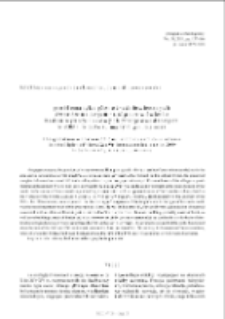
Obiekt
Tytuł: Problematyka późnośredniowiecznych dworów na kopcu na Śląsku w świetle badań wykopaliskowych przeprowadzonych w 2009 r. w Bełczu Małym gm. Wąsosz
Inny tytuł:
Ausgrabungen auf dem spätmittelalterlichen Turmhügel von Klein Beltsch in Niederschlesien (Bełcz Mały, gm. Wąsosz, woj. dolnośląskie) ; Przegląd Archeologiczny T.59 (2011)
Współtwórca:
Kieseler, Andreas ; Nowakowski, Dominik
Wydawca:
Instytut Archeologii i Etnologii Polskiej Akademii Nauk ; Ośrodek Badań nad Kulturą Późnego Antyku i Wczesnego Średniowiecza
Miejsce wydania:
Opis:
il. ; 29 cm ; Bibliogr. s.162-164
Typ obiektu:
Abstrakt:
The paper concerns the question of research on small knight’s seats in Silesia. Results of excavations carried out in the area and in surroundings of the knight’s seat in Bełcz Mały gave rise to the research on the subject. There, the preserved complex is located on a small hill in the valley of the Barycz river, approximately 150 m northwest of the village. A quadrilateral embankment 55 x 60 m in size, surrounded by a moat 20 m wide and an outer rampart, is the main element of the castle. In the course of the excavations, cultural layers connected with an open settlement of the Lusatian culture, dated to the V phase of the Bronze Age and Hallstatt C, as well as early medieval material, dated generally to the 2nd half of the 11th – the 13th centuries, were exposed. The discovering of two phases of the knight’s seat in the type of the motte castle was the most important result of the excavations. The castle was built on the hill, elevated by the accumulation of material connected with an older settlement, just on the bank of the Barycz river. The main building, probably made of brick, as well as outbuildings, made of timber and clay, were erected at the courtyard surrounded by a palisade. On the basis of dendrochronological dating of wood samples and of the analysis of clay vessels, it can be determined that the castle functioned since the turn of the 14th and 15th centuries to around the third quarter of the 15th century. In the course of the excavations, relics of a wooden bridge, built over the river around the turn of the 14th and 15th centuries as well, were discovered
Czasopismo/Seria/cykl:
Tom:
Strona pocz.:
Strona końc.:
Szczegółowy typ zasobu:
Format:
Identyfikator zasobu:
oai:rcin.org.pl:50750 ; 0079-7138
Źródło:
IAiE PAN, sygn. P III 149 ; IAiE PAN, sygn. P III 272 ; IAiE PAN, sygn. P III 353 ; kliknij tutaj, żeby przejść
Język:
Język streszczenia:
Prawa:
Prawa zastrzeżone - dostęp ograniczony
Zasady wykorzystania:
Digitalizacja:
Instytut Archeologii i Etnologii Polskiej Akademii Nauk
Lokalizacja oryginału:
Biblioteka Instytutu Archeologii i Etnologii PAN
Dofinansowane ze środków:
Ministra Nauki i Szkolnictwa Wyższego
Dostęp:
Kolekcje, do których przypisany jest obiekt:
- Repozytorium Cyfrowe Instytutów Naukowych > Kolekcje Partnerów > Instytut Archeologii i Etnologii PAN > Publikacje Pracowników i Wydawnictwa IAE PAN
- Repozytorium Cyfrowe Instytutów Naukowych > Kolekcje Partnerów > Instytut Archeologii i Etnologii PAN > Publikacje Pracowników i Wydawnictwa IAE PAN > Czasopisma bieżące
- Repozytorium Cyfrowe Instytutów Naukowych > Piśmiennictwo > Czasopisma/Artykuły
- Repozytorium Cyfrowe Instytutów Naukowych > Kolekcje Partnerów > Instytut Archeologii i Etnologii PAN > Publikacje Pracowników i Wydawnictwa IAE PAN > Czasopisma bieżące > Przegląd Archeologiczny
Data ostatniej modyfikacji:
2 lut 2022
Data dodania obiektu:
29 gru 2014
Liczba pobrań / odtworzeń:
187
Wszystkie dostępne wersje tego obiektu:
https://www.rcin.org.pl/publication/69724
Wyświetl opis w formacie RDF:
Wyświetl opis w formacie RDFa:
Wyświetl opis w formacie OAI-PMH:
Obiekty Podobne
Wółkiewicz, Ewa
Michalak, Arkadiusz
Długoborski, Wacław (1926– )
Szaynok, Bożena (1965– )
Wółkiewicz, Ewa
Biermann, Felix
Purowski, Tomasz
Skubała, Piotr Polska Akademia Nauk. Muzeum i Instytut Zoologii

 INSTYTUT ARCHEOLOGII I ETNOLOGII POLSKIEJ AKADEMII NAUK
INSTYTUT ARCHEOLOGII I ETNOLOGII POLSKIEJ AKADEMII NAUK
 INSTYTUT BADAŃ LITERACKICH POLSKIEJ AKADEMII NAUK
INSTYTUT BADAŃ LITERACKICH POLSKIEJ AKADEMII NAUK
 INSTYTUT BADAWCZY LEŚNICTWA
INSTYTUT BADAWCZY LEŚNICTWA
 INSTYTUT BIOLOGII DOŚWIADCZALNEJ IM. MARCELEGO NENCKIEGO POLSKIEJ AKADEMII NAUK
INSTYTUT BIOLOGII DOŚWIADCZALNEJ IM. MARCELEGO NENCKIEGO POLSKIEJ AKADEMII NAUK
 INSTYTUT BIOLOGII SSAKÓW POLSKIEJ AKADEMII NAUK
INSTYTUT BIOLOGII SSAKÓW POLSKIEJ AKADEMII NAUK
 INSTYTUT CHEMII FIZYCZNEJ PAN
INSTYTUT CHEMII FIZYCZNEJ PAN
 INSTYTUT CHEMII ORGANICZNEJ PAN
INSTYTUT CHEMII ORGANICZNEJ PAN
 INSTYTUT FILOZOFII I SOCJOLOGII PAN
INSTYTUT FILOZOFII I SOCJOLOGII PAN
 INSTYTUT GEOGRAFII I PRZESTRZENNEGO ZAGOSPODAROWANIA PAN
INSTYTUT GEOGRAFII I PRZESTRZENNEGO ZAGOSPODAROWANIA PAN
 INSTYTUT HISTORII im. TADEUSZA MANTEUFFLA POLSKIEJ AKADEMII NAUK
INSTYTUT HISTORII im. TADEUSZA MANTEUFFLA POLSKIEJ AKADEMII NAUK
 INSTYTUT JĘZYKA POLSKIEGO POLSKIEJ AKADEMII NAUK
INSTYTUT JĘZYKA POLSKIEGO POLSKIEJ AKADEMII NAUK
 INSTYTUT MATEMATYCZNY PAN
INSTYTUT MATEMATYCZNY PAN
 INSTYTUT MEDYCYNY DOŚWIADCZALNEJ I KLINICZNEJ IM.MIROSŁAWA MOSSAKOWSKIEGO POLSKIEJ AKADEMII NAUK
INSTYTUT MEDYCYNY DOŚWIADCZALNEJ I KLINICZNEJ IM.MIROSŁAWA MOSSAKOWSKIEGO POLSKIEJ AKADEMII NAUK
 INSTYTUT PODSTAWOWYCH PROBLEMÓW TECHNIKI PAN
INSTYTUT PODSTAWOWYCH PROBLEMÓW TECHNIKI PAN
 INSTYTUT SLAWISTYKI PAN
INSTYTUT SLAWISTYKI PAN
 SIEĆ BADAWCZA ŁUKASIEWICZ - INSTYTUT TECHNOLOGII MATERIAŁÓW ELEKTRONICZNYCH
SIEĆ BADAWCZA ŁUKASIEWICZ - INSTYTUT TECHNOLOGII MATERIAŁÓW ELEKTRONICZNYCH
 MUZEUM I INSTYTUT ZOOLOGII POLSKIEJ AKADEMII NAUK
MUZEUM I INSTYTUT ZOOLOGII POLSKIEJ AKADEMII NAUK
 INSTYTUT BADAŃ SYSTEMOWYCH PAN
INSTYTUT BADAŃ SYSTEMOWYCH PAN
 INSTYTUT BOTANIKI IM. WŁADYSŁAWA SZAFERA POLSKIEJ AKADEMII NAUK
INSTYTUT BOTANIKI IM. WŁADYSŁAWA SZAFERA POLSKIEJ AKADEMII NAUK


































